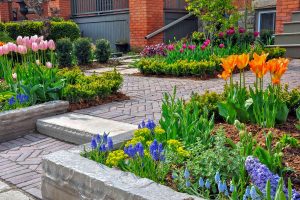Home gardening is a popular hobby that not only provides an opportunity to connect with nature, but also allows individuals to grow their own fruits and vegetables, saving them money and providing a healthier alternative to store-bought produce. However, for beginners, the thought of starting a home garden can be daunting. The Green Thumb: A Beginner’s Guide to Home Gardening aims to provide a comprehensive guide for those who are new to home gardening, covering everything from choosing the right location to maintaining a healthy and thriving garden.
Choosing the Right Location
The first step in starting a home garden is choosing the right location. The location of your garden will play a crucial role in its success, as different plants have different requirements when it comes to sunlight, soil, and water. Here are some factors to consider when choosing the right location for your garden:
1. Sunlight: Most vegetables and fruits require at least six hours of direct sunlight per day. If your garden location receives less than six hours of sunlight, you may want to consider planting shade-tolerant plants such as lettuce, spinach, or herbs.
2. Soil: Different plants have different soil requirements. Some plants prefer well-draining soil, while others prefer soil that is rich in organic matter. It’s important to test your soil to determine its pH level and nutrient content. Based on the results, you can adjust your soil accordingly.
3. Water: Your garden location should be close to a water source, such as a hose or a watering can. It’s important to ensure that your plants receive enough water, especially during hot and dry weather.
4. Accessibility: Your garden location should be easily accessible, allowing you to tend to your plants regularly without straining your back or knees.
Preparing the Soil
Once you have chosen the right location for your garden, it’s time to prepare the soil. Preparing the soil is a crucial step in starting a home garden, as it ensures that your plants have the necessary nutrients and support to grow healthy and strong. Here are some steps to follow when preparing your soil:
1. Test your soil: It’s important to test your soil to determine its pH level and nutrient content. You can purchase a soil testing kit at your local gardening store or send a sample to a lab for analysis.
2. Add organic matter: Organic matter such as compost, manure, or peat moss can help improve your soil’s structure and fertility. Add a 2-inch layer of organic matter to the top of your soil and mix it in well.
3. Remove debris: Clear your garden bed of any debris such as rocks, twigs, and weeds. You can use a garden fork or spade to remove larger debris, and a hand trowel or cultivator to remove smaller debris.
4. Till the soil: Till the soil to a depth of 8-10 inches to loosen it and remove any clumps. You can use a garden tiller or a shovel to till the soil.
5. Rake the soil: Use a garden rake to smooth out the soil and create a flat surface.
Planting Your Garden
Now that your soil is prepared, it’s time to start planting your garden. Here are some steps to follow when planting your garden:
1. Choose the right plants: Choose plants that are suitable for your climate and the amount of sunlight your garden receives. You can consult with a local nursery or gardening expert to determine which plants are best for your area.
2. Start seeds indoors: If you want to get a head start on the growing season, you can start seeds indoors 4-6 weeks before the last frost date. Use seed trays or small pots with a good seed-starting mix.
3. Plant seeds or seedlings: Once the danger of frost has passed, you can plant your seeds or seedlings in your garden. Space them appropriately according to the seed package or plant label.
4. Water your plants: Water your plants thoroughly after planting, and continue to water them regularly during the first few weeks until they become established.
Maintaining Your Garden
Maintaining your garden is just as important as starting it. Here are some tips to help you keep your garden healthy and thriving:
1. Water regularly: Most plants require at least 1-2 inches of water per week. You can use a rain gauge to measure the amount of water your garden receives.
2. Mulch your garden: Mulch helps retain moisture, suppress weeds, and regulate soil temperature. Use a 2-3 inch layer of organic mulch such as straw, bark chips, or grass clippings.
3. Fertilize: Fertilize your plants regularly according to the seed package or plant label. You can also use compost tea as a natural fertilizer.
4. Monitor for pests and diseases: Regularly inspect your plants for signs of pests or diseases. Use natural methods of control such as introducing beneficial insects or spraying with neem oil.
5. Prune and train: Prune your plants to encourage healthy growth and production. Train climbing plants such as tomatoes or peas to grow up trellises or stakes.
Starting a home garden can seem daunting, but with the right information and preparation, it can be a rewarding and enjoyable hobby. By following the steps outlined in this guide, you can create a thriving garden that provides you with fresh, healthy produce and a sense of accomplishment. Happy gardening!
















Add Comment